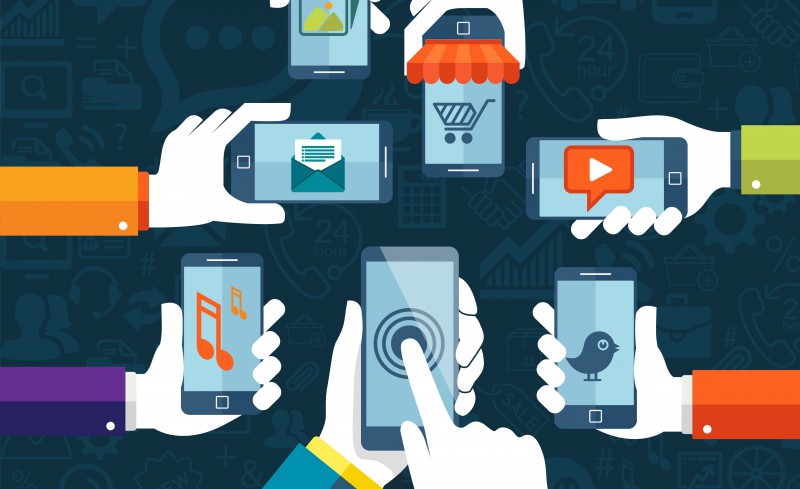If it wasn’t apparent before 2015, it’s now as clear as a slap in the face – mobile has changed eCommerce permanently.
Over half of consumers in the US are now using mobile for shopping and that figure will undoubtedly grow again this year. This is forcing retailers to evolve their businesses to support and leverage mobile commerce.
What will the explosion of mobile mean for retailers? We look at the key trends.
mobile, Mobile, MOBILE
A few warm-up stats to illustrate how mCommerce lit up 2015, and why we think mCommerce will become the word on everyone’s lips in 2016.
- In the UK alone, the retail industry is sacrificing £6.6 billion by not going mobile (econsultancy). Expect that sacrifice to be well and truly forfeited this year.
- The majority of US online sales stemmed from mobile, while mobile accounted for 40% of all online sales in the UK. Mobile is a hungry beast that’s going to keep eating.
- Mobile sales have in the US have grown by 78% since 2013 and is predicted to grow by a further 95% by 2019 (Statista). There is acres of room for growth.
What’s more, mobile is piggybacking off a growing market – general online sales. This Eurostat chart shows online purchases and sales in the EU are steadily growing.
With the burgeoning of eCommerce, much of its global growth is being driven by mCommerce.
Reward Customers Anytime
Let the Nielsen Global Connected Commerce Survey explain (in academic terms) what sellers need to do.
“Retailers must move from a linear marketing approach to a value exchange model in which customers receive a tangible, personally relevant benefit for their time and attention.’’
In plain English, reward your customers.
The growth of mobile shopping means you can potentially connect to – and reward – your customers anytime, anywhere. Remember, it’s potentially seven times more expensive to get a new customer than retain an existing one (Invesp). Appreciate the loyal ones.
Be creative with how and when you choose to reward loyalty too. By surprising and delighting your customers, you enhance brand perception.
- According to eMarketer, the five most appealing “surprise and delight” rewards are:
- Special privileges for being a longtime customers
- Surprise discounts after spending a lot with a retailer during a given month
- Free samples of products based on purchase history
- Special holiday gifts based on what they often purchase
Before smartphones, digital marketing was limited to desktop communications. Now you can connect to your customers at any time via mCommerce – from morning email checks in bed to browsing on the evening commute.
This provides sellers with unique opportunities to target customers with specific, but creative, messaging. You can tailor your marketing in line with the products you sell.
Take computer game sellers. Your customers may be in work on a Monday morning on a laptop going through a mountain of emails – a total good mood killer. Just as they get over the peak of their email mountain around 11am, comes an opportunity for the seller to cheer them up. Or better: surprise and delight them.
“Make it the best gaming week of your life. Buy (insert game title) before Friday for just $20!”
I don’t know about you, but as a moderate gamer, that would be enough to make my Monday.
This kind of granular, super-specific targeting is what makes mobile so unique in terms of how you reach your customers.
Mobile has given sellers new avenues to reach out to customers and offer a better shopping experience. Customers love variety. Think outside the box and change it up every now and then.
Why some sellers still won’t benefit
Bad Customer Service
It’s simple. Bad customer service = no sale.
A whopping 89% of shoppers stopped buying from online stores after they received poor customer service (RightNow).
Smartphones becoming the dominant shopping device means support ticket volumes may be less predictable. Your customer support teams may need to adapt. Being active during key online shopping periods has become more important than responding within business hours.
The knock-on effect is powerful. Timely, swift and problem-solving responses will lead to more sales, better feedback, better response times, leading to a better seller rating, which in turn will lead to even more sales. It’s a beautifully simple cycle.
Not only can great customer support win you new customers and increase your sales, but it can also increases your prices.
According to the RightNow survey, a staggering 86% of consumers are willing to pay up to 25% more to get a better customer experience. If you offer the best service on the (virtual) block, people will pay for it.
In the event of a dispute with a difficult customer, it’s better to take the hit even if you think you’re right. Why? Because 70% of complaining customers will buy from you again if you resolve the complaint in their favour (CSM). That’s a big incentive to say sorry.
Solution? Make your customer support excellent in every way possible, including language, response and resolutions times, scalability and streamline your channels.
Bad Mobile Experience
In the UK, retailers reported mobile sales doubling from 2013 to 2014, but 17% still have no mobile offering.
On top of this, 30% of mobile shoppers abandon a transaction if the shopping experience is not optimized for mobile (MoPowered). That is a lot of lost business. Conversely, if you provide a good experience, 61% of customers will have a better opinion of your brand.
Have you optimized your website for mobile? How smooth is the shopping journey? Investing in mobile web design and user experience may be initially expensive, but could stop you losing thousands of potential customers per year.
Another crucial part of the mobile experience is speed. If your site takes longer than 3 seconds to load, you’ll lose over half of your potential customers.
Learn more about mobile experience in SelfStartr’s 7 Mobile UX Fails that are killing your eCommerce site.
Bad Feedback
Feedback matters regardless of device. But on mobile, you may have less of the consumer’s attention. Due to screen size displaying less information or just from being on-the-go, consumers may make quicker decisions based on less info. The consequence? The consumer sees your seller rating and decides whether to buy from you there and then.
As customers, what’s the first thing we do when we see poor feedback on a seller’s web store? Easy – find the same product on a store with a better rating.
Feedback is an essential driver in the growth of mCommerce. An overwhelming 73% of Nielsen’s respondents say they use online reviews to make purchase decisions.
Amazon sellers will already know the importance of feedback and mobile. The feedback-driven seller rating is a key factor in winning the Buy Box. Once you win the mobile Buy Box,it will only display your product. This means there is greater probability of a purchase compared with desktop, as desktop displays competing offers under the Buy Box.
Local search company BrightLocal reported that 88% of consumers trust online reviews as much as personal recommendations. Feedback is the heavyweight player in informing customers’ purchasing choices. Make sure when they read your feedback, the pros far outweigh the cons.
Mobile Checklist for Sellers
Today’s shoppers want digital touchpoints along the entire purchase path, from reading reviews to using smartphones as personal shopping assistants. Bear in mind, consumers spend the most time on three activities on mobile: deal-seeking, info-gathering and reading reviews.
Mobile-first means adding value to the customer journey over the entire shopping experience. Here is a quick checklist to make sure you’re covering the basics of mobile selling.
- Mobile attention span is short: Optimize product listings to emphasize product advantages at the top
- Appeal to customers’ deal-seeking behaviours in creative ways
- Reward your returning customers
- Invest in developing a mobile-friendly version of your website, if you haven’t already
- SEO: make sure your business is easy to find on mobile search engines
- Use high-quality, multi angle product photos
- Encourage customer feedback. Positive reviews are gold.
Got any mCommerce tips of your own? We’d love to hear your comments. Just comment below and we can have a casual chat about the future of mCommerce.








